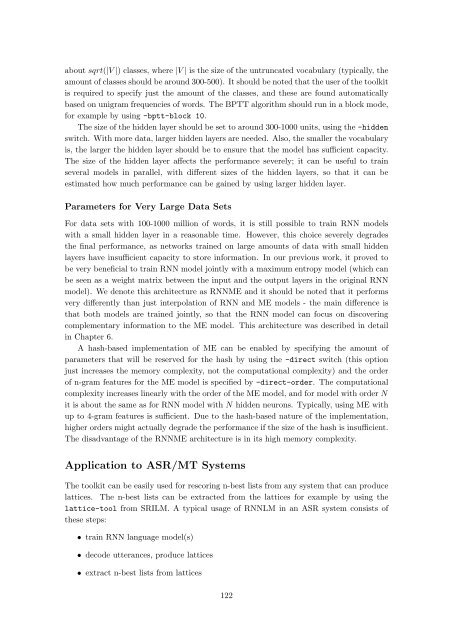Statistical Language Models based on Neural Networks - Faculty of ...
Statistical Language Models based on Neural Networks - Faculty of ...
Statistical Language Models based on Neural Networks - Faculty of ...
You also want an ePaper? Increase the reach of your titles
YUMPU automatically turns print PDFs into web optimized ePapers that Google loves.
about sqrt(|V |) classes, where |V | is the size <strong>of</strong> the untruncated vocabulary (typically, the<br />
amount <strong>of</strong> classes should be around 300-500). It should be noted that the user <strong>of</strong> the toolkit<br />
is required to specify just the amount <strong>of</strong> the classes, and these are found automatically<br />
<str<strong>on</strong>g>based</str<strong>on</strong>g> <strong>on</strong> unigram frequencies <strong>of</strong> words. The BPTT algorithm should run in a block mode,<br />
for example by using -bptt-block 10.<br />
The size <strong>of</strong> the hidden layer should be set to around 300-1000 units, using the -hidden<br />
switch. With more data, larger hidden layers are needed. Also, the smaller the vocabulary<br />
is, the larger the hidden layer should be to ensure that the model has sufficient capacity.<br />
The size <strong>of</strong> the hidden layer affects the performance severely; it can be useful to train<br />
several models in parallel, with different sizes <strong>of</strong> the hidden layers, so that it can be<br />
estimated how much performance can be gained by using larger hidden layer.<br />
Parameters for Very Large Data Sets<br />
For data sets with 100-1000 milli<strong>on</strong> <strong>of</strong> words, it is still possible to train RNN models<br />
with a small hidden layer in a reas<strong>on</strong>able time. However, this choice severely degrades<br />
the final performance, as networks trained <strong>on</strong> large amounts <strong>of</strong> data with small hidden<br />
layers have insufficient capacity to store informati<strong>on</strong>. In our previous work, it proved to<br />
be very beneficial to train RNN model jointly with a maximum entropy model (which can<br />
be seen as a weight matrix between the input and the output layers in the original RNN<br />
model). We denote this architecture as RNNME and it should be noted that it performs<br />
very differently than just interpolati<strong>on</strong> <strong>of</strong> RNN and ME models - the main difference is<br />
that both models are trained jointly, so that the RNN model can focus <strong>on</strong> discovering<br />
complementary informati<strong>on</strong> to the ME model. This architecture was described in detail<br />
in Chapter 6.<br />
A hash-<str<strong>on</strong>g>based</str<strong>on</strong>g> implementati<strong>on</strong> <strong>of</strong> ME can be enabled by specifying the amount <strong>of</strong><br />
parameters that will be reserved for the hash by using the -direct switch (this opti<strong>on</strong><br />
just increases the memory complexity, not the computati<strong>on</strong>al complexity) and the order<br />
<strong>of</strong> n-gram features for the ME model is specified by -direct-order. The computati<strong>on</strong>al<br />
complexity increases linearly with the order <strong>of</strong> the ME model, and for model with order N<br />
it is about the same as for RNN model with N hidden neur<strong>on</strong>s. Typically, using ME with<br />
up to 4-gram features is sufficient. Due to the hash-<str<strong>on</strong>g>based</str<strong>on</strong>g> nature <strong>of</strong> the implementati<strong>on</strong>,<br />
higher orders might actually degrade the performance if the size <strong>of</strong> the hash is insufficient.<br />
The disadvantage <strong>of</strong> the RNNME architecture is in its high memory complexity.<br />
Applicati<strong>on</strong> to ASR/MT Systems<br />
The toolkit can be easily used for rescoring n-best lists from any system that can produce<br />
lattices. The n-best lists can be extracted from the lattices for example by using the<br />
lattice-tool from SRILM. A typical usage <strong>of</strong> RNNLM in an ASR system c<strong>on</strong>sists <strong>of</strong><br />
these steps:<br />
• train RNN language model(s)<br />
• decode utterances, produce lattices<br />
• extract n-best lists from lattices<br />
122







